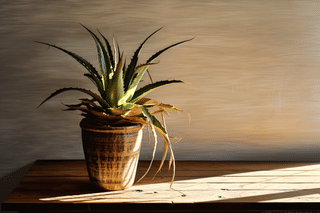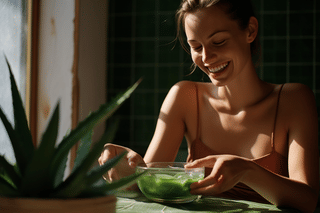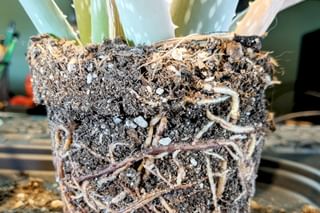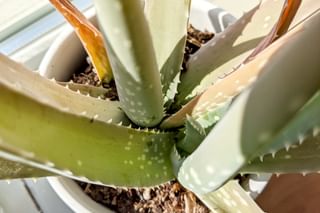How to care for an Aloe Vera
The Aloe Vera is a beautiful succulent-like cactus that has many health benefits besides being a great beginner-friendly houseplant. In this plant care guide, we're going to discover how you can help your Aloe Vera grow and stay healthy.
 An Aloe Vera is a succulent-like cactus that has many health benefits. They don't just look great, but you can also use them to treat burns and have other health benefits.
An Aloe Vera is a succulent-like cactus that has many health benefits. They don't just look great, but you can also use them to treat burns and have other health benefits.
Aloe veras are great plants for those of you who don't have a lot of time to take care of your plants or always forget to water them. The Aloe Vera needs very little from you and thrives when it's neglected for weeks at a time.
In this plant care guide, we're going to learn how to take care of the Aloe Vera and help it be happy. These are the topics we're going to highlight:
Let's get into these aspects of taking care of an Aloe Vera and learn how to help this amazing plant grow and be happy.
Sunlight requirements for an Aloe Vera

An Aloe Vera is very much like a cactus in many ways. It has sharp thorns, but also loves a lot of sunlight. Aloe Vera is a sun-loving plant that flourishes in bright, direct light. Placing your Aloe Vera in direct sunlight for a few hours each day will do wonders for its growth and health. Aloe plants are native to hot, arid regions of Africa and need plenty of light to thrive.
Aloe vera in direct sunlight
When placing your Aloe Vera in direct sunlight, it's important to keep some things in mind. First, make sure the plant is getting enough water to keep it hydrated, as direct sunlight can quickly dry out the soil. It's a great plant to put right next to your window if you live in a colder climate, but you can also grow them outdoors if you live in a hot and dry place.
If you live in a particularly hot climate, you may want to consider moving your Aloe Vera to a spot with some shade during the hottest part of the day to prevent sunburn.
When you expose your Aloe Vera to a lot of sunlight, it starts to grow. In the same way, if you put it in a place that's too dark, it will stop growing and become dormant. You could use this as a way to keep your Aloe Vera smaller, but it's better to keep it happy in the sun and propagate it when it gets too big for its spot. This way you have more of them and you could share them with your friends and family.
With proper care, your Aloe Vera will grow healthy and strong in direct sunlight, producing plump, juicy leaves filled with powerful healing properties. So go ahead and give your Aloe Vera some sunshine today!
Can I keep my Aloe Vera indoors, or does it need to be outside?
As we've discovered in the previous section, Aloe vera thrives in lots of sunlight. Aloe Vera is a highly versatile succulent that can be kept indoors or outdoors, depending on your preference and environment. This plant is adaptable to a range of light conditions, making it a great choice for indoor locations with low to moderate light.
So you can keep an Aloe Vera indoors and it will thrive in sunny spots. Just keep in mind that this plant won't grow as quickly or as large as it would if it were growing in its native habitat outside. It's a slow-growing plant indoors, even if you keep it in direct sunlight all the time.
Growing Aloe vera outside
If you choose to keep your Aloe Vera plant outside, make sure it is in a sunny location, with well-draining soil and adequate watering. Aloe Vera plants are known for their hardiness and can withstand some neglect. However, it is important to monitor the plant's growth and adjust conditions accordingly to make sure that it remains healthy and thriving.
Aloe Vera plants will do especially well outdoors if you live in a dry and hot climate. If you live in a particularly hot climate, you may want to consider moving your Aloe Vera to a spot with some shade during the hottest part of the day to prevent sunburn.
Make sure to protect your Aloe vera from too much rain and cold air, because these two factors will make it very difficult for this plant to stay healthy in the long term.
Watering your Aloe Vera

How often should you water an Aloe vera?
Aloe Vera plants are easy to take care of; however, the frequency of watering them depends on a few things. Before you water your Aloe Vera, you should always check the soil's moisture level before watering it. The best time to water your Aloe Vera is when it has been dry for a few days. This gives it plenty of time to thrive in the dry soil, without being under watered.
A good rule of thumb is to water your plant every two to three weeks during the summer and spring months, and every four to six weeks in the winter and fall when the plant is dormant.
Another factor that affects how often you should water your Aloe Vera is the temperature and sunlight exposure it gets. The warmer and brighter the environment, the faster the soil will dry out. So, if your Aloe Vera plant is in a sunny window, you will need to water it more often than a plant in a shadier spot.
How to water an Aloe vera?
When you water your Aloe Vera, make sure to water it thoroughly. This plant has deep roots, unlike some succulents. If you were to water your Aloe Vera more often, but only a little every time, the moisture will never reach the roots of the plant. By watering it thoroughly, you can make sure that the moisture reaches throughout the whole pot and the roots can absorb the moisture.
It's very important to have proper drainage holes to get rid of any excess water. Your Aloe Vera can't survive in moist environments for very long. If you have water collecting at the bottom of the pot, this could be very harmful and kill your plant.
Aloe Vera plants are susceptible to root rot, which can be caused by overwatering or watering too often. To avoid this, always make sure the soil is dry before watering and provide your plant with excellent drainage.
Can you use tap water for an Aloe Vera plant?
Using tap water to water your aloe vera plant is perfectly fine. Aloe vera is known for its resilience and ability to adapt to different environmental conditions. However, there are a few steps you should take.
It's important to know that not all tap water is created equal. The quality of tap water can vary greatly depending on your location. Some areas have higher levels of minerals and chemicals in their water supply, which can be harmful to your plant over time. Keep an eye out for signs of mineral buildup on your plant's leaves or in the soil.
To make sure that your plant is getting the best possible water, it's a good idea to use a filter or let the water sit out for a few hours before watering. This allows any chlorine or fluoride to evaporate and reduces the risk of mineral buildup in your soil.
I always like to say: "If you can safely drink the water, so can your plant".
The best soil for an Aloe Vera
An Aloe Vera thrives in dry environments. The easiest way to give it this dry environment is to plant it in soil that drains moisture very well. The best soil for an Aloe Vera is cactus soil: a lot of Perlite and/or sand mixed in with potting soil. This helps the soil to drain moisture away quickly, as the Aloe Vera does not tolerate moist soil very well.
An Aloe Vera is also a great plant for rock gardens, as this drains any moisture away very quickly. You could even plant your Aloe Vera in Leca or Pumice, as these growing mediums drain away moisture instantly and water your plant slowly.
As you can see, there are many great ways to help your Aloe Vera stay in a dry environment.
Fertilizing an Aloe Vera
Plants need energy to grow, even if they grow quite slowly. You can give these plants the extra energy by fertilizing them regularly. Aloe Vera, like many other plants, has a growing period and a dormancy period.
During the growing period (spring and summer), your plant grows more quickly than during the dormancy period. The dormancy period (fall and winter) is when your houseplants rest. During the growing period, you should fertilize your Aloe Vera twice: once during the spring and once during the summer.
It's best to fertilize them at the beginning of the season, so it can use all of this extra energy to grow bigger and stronger. You shouldn't fertilize your plants during the dormancy period, as they won't use the fertilizer at all.
If your plant doesn't use the fertilizer you give it, it stays behind in the soil and will make the soil acidic. This makes it a very tough place for your plant to grow and stay healthy. When this happens, you can wash the fertilizer away by watering your plant thoroughly and letting the moisture drain.
Can I use any type of fertilizer an Aloe Vera?
Aloe Vera is a hardy plant and can benefit from a variety of different fertilizers. However, it is important to follow a few guidelines to make sure that you are providing your Aloe Vera with the best possible care.
It's best to use a balanced fertilizer that includes equal parts nitrogen, phosphorus, and potassium (NPK). This will make sure that your Aloe Vera gets all the nutrients it needs to thrive. Also, using a slow-release fertilizer can be beneficial, as it will release nutrients gradually over time, providing your plant with nutrients for a longer period.
When fertilizing your Aloe Vera, make sure to follow the instructions on the label of the fertilizer you've gotten. By following the instructions you prevent burning the delicate roots and leaves of your plant. You can apply the diluted fertilizer by pouring it directly onto the soil around the base of the plant.
Propagating an Aloe Vera
Sometimes, you might want to propagate your Aloe Vera. Perhaps your plant is getting too big for its spot or you just want more of them. Luckily, propagating an Aloe Vera, like many succulents, is quite easy.
You can propagate an Aloe Vera by cutting off one of its leaves and letting the end dry for 2 days. You can let the end dry by putting it in a warm and sunny place. You need to wait for a callus to form at the place where you cut it off from the parent plant. It's important to wait for the callus to form because this protects your Aloe Vera against diseases when you plant it in soil.
When the callus has formed, after around 2 days, you can stick it in the soil. The thorns are sharp, so be careful while handling the leaves. After you've planted it in the soil, you can water your plant like you've learned earlier in this guide. Don't worry about the Aloe Vera drying out when it doesn't have roots. Its fleshy leaves contain a lot of moisture, so they will be fine.
Your Aloe Vera starts to grow roots out of the bottom, where the callus has formed, after a few weeks. At this point, you'll have a completely new plant, and you'll see new leaves grow soon after.
Repotting an Aloe Vera
To keep your aloe vera healthy and thriving, it is important to pay attention to signs that indicate it may need to be repotted. Let's discover the signs your plant shows you it's time to move your aloe vera to a larger pot.
First, check the root system. If you notice roots growing out of the drainage holes at the bottom of the pot or they start to circle the bottom, it is a clear sign that the plant has outgrown its current container. If you can see the roots becoming matted and turning brown, this could mean that they are struggling to absorb water and nutrients from the soil.
Another sign that your aloe vera needs to be repotted is when the soil has become compacted and dry. This prevents the soil from absorbing more of the water and prevents proper drainage, which can cause the plant to wilt and become less healthy overall.
You may also notice that your aloe vera has become too large for its current pot - the leaves may appear crowded and the plant may be unstable. Repotting will give the roots more space to grow and provide stability for the plant.
Can I trim the roots of my Aloe Vera when repotting?
Trimming the roots of your Aloe Vera when repotting can benefit the plant in several ways. First, it allows you to remove any damaged or dead roots that may have built up over time. These roots can be a source of harmful bacteria and fungi and will affect the overall health of your plant. By removing them, you can help your Aloe Vera to stay healthy.
Trimming the roots can also encourage new growth. When you remove some of the older and larger roots, it stimulates the plant to produce new roots. This can help the plant to absorb nutrients and water more efficiently and lead to stronger and healthier growth.
When trimming the roots, it's important to use sharp and clean scissors or shears. Avoid using dull tools, as they can cause more damage to the roots than necessary. You should also trim only the outer edges of the roots, without taking off too much at once. Aim to remove a maximum of 1/3 of the roots while repotting your plant.
What should I do if my Aloe Vera's leaves turn brown?

Inspect the plant
Take a closer look at the brown leaves to see if there are any signs of pests or disease. If you notice any issues, treat them accordingly.
Check the soil
Make sure the soil is not too wet or too dry. Aloe Vera plants prefer well-draining soil, so if the soil is waterlogged, it could be causing the brown leaves. If the soil is dry, give your plant a good watering.
Adjust lighting
Aloe Vera plants love bright light. If your plant is not getting enough light, it could be causing the leaves to turn brown. Move your plant to a brighter spot or provide artificial light if necessary.
Cut off brown leaves
If the brown leaves are affecting the overall appearance of your plant, feel free to trim them off. Be sure to use a sharp, sterilized knife or scissors to avoid harming the plant.
How long does it take for an Aloe Vera to grow new leaves?
If you're growing an Aloe Vera plant, you might be wondering how long it takes for new leaves to sprout. Aloe Vera is a slow-growing plant, so patience is important when it comes to new growth.
Usually, an Aloe Vera plant will grow new leaves every few months. However, this depends on a few things, like proper lighting, watering, and soil conditions.
To make sure your Aloe Vera plant grows healthy and strong, it's essential to give it plenty of bright, indirect sunlight. Also, be sure not to overwater your Aloe Vera, as the plant prefers dry conditions and can easily develop root rot if it's too wet. In terms of soil, Aloe Vera prefers well-draining soil that's not too rich in nutrients.
If you provide your Aloe Vera plant with the right conditions, you should see new leaves sprouting every few months. Don't get discouraged if the growth seems slow - Aloe Vera is a low-maintenance plant that will reward you with its unique beauty and health benefits.
Can I use aloe vera gel directly from the plant for skin care?

Aloe vera is a powerful and natural ingredient that has been used for centuries for its medicinal properties. This succulent is full of vitamins, minerals, and antioxidants that make it an excellent choice for skin care. Not only does it have healing properties that soothe sunburns and other skin irritations, but it also contains compounds that help moisturize and rejuvenate the skin.
To use aloe vera gel directly from the plant, simply snap off a leaf and squeeze out the gel. It's important to use freshly cut leaves, as the gel can lose its potency over time. Gently massage the gel onto your skin, taking care to avoid the eye area. Leave it on for about 10-15 minutes before rinsing off with cool water.
You can also use aloe vera gel as a daily moisturizer or as a base for DIY face masks. It's gentle enough to use on all skin types and can help reduce redness and inflammation.
Conclusion
The Aloe Vera is a beautiful succulent-like cactus that has many health benefits besides being a great beginner-friendly houseplant. It's a hands-off plant that thrives when you forget about it for a few weeks. It needs plenty of direct sunlight, so place it close to a window. It doesn't need to be watered a lot, because it loves the dry soil. Water it about every two weeks, and it'll be a happy houseplant.
Thank you for reading this post! I hope it helps you to keep your plants healthy and beautiful! If you're looking for more guides on specific plants, you can always request a plant guide to get a guide for the plant you have trouble with.
Test your plant care knowledge
Quiz completed!
Want to learn more? Sign up for my newsletter to receive free tips in your inbox!
Sign up now!










